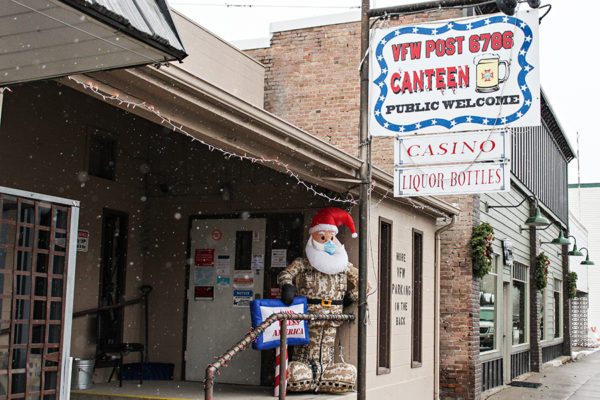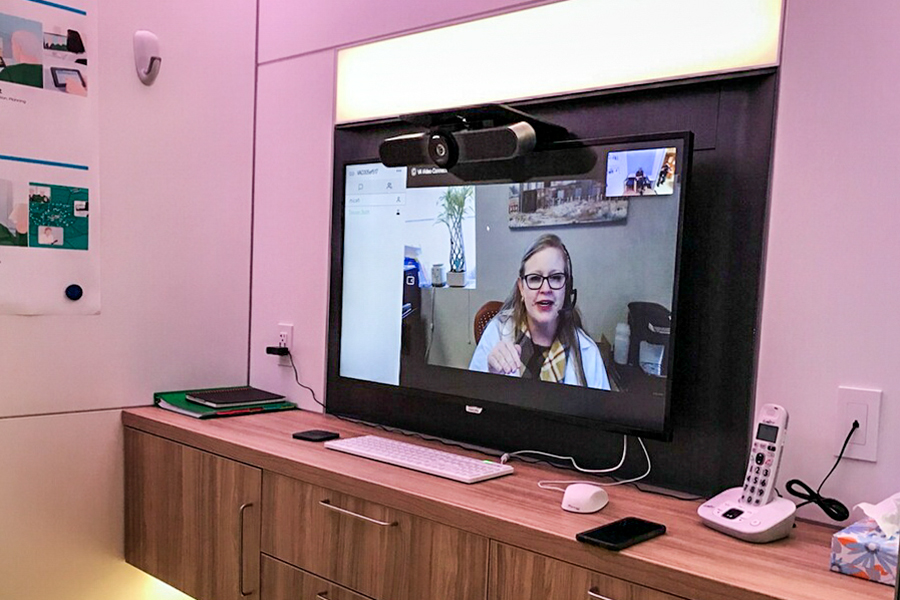The town of Eureka has fewer than 1,500 residents, but boasts one of the highest concentrations of veterans anywhere in the nation. Just over 400 veterans live within a half-hour drive of Lincoln County’s second largest town.
In terms of access to healthcare through the U.S. Department of Veterans Affairs (VA), Eureka is one of the most remote areas in the state. The nearest VA clinic is an hour away in either Kalispell or Libby, and the nearest VA hospitals, in Spokane and Helena, require more than four hours on the road each way.
This seclusion led Eureka to rise to the top of a list of contenders for the VA Accessing Telehealth Through Local Area Stations (ATLAS) program, meant to increase access and availability of telehealth for rural veterans. However, as a town bereft of a single stoplight, it was unknown whether the veteran community would be open to a high-tech solution.
On a recommendation from the state VFW quartermaster, officials with VA approached Rick Weldon, commander of Eureka VFW post 6786, in the summer of 2018 with a rough outline for what would become the Project ATLAS Pod.

“In the developmental process, you have to plant that seed somewhere,” Weldon said. “I have a pacemaker, and I have to drive five hours one way to get my annual 10-minute checkup.”
A partnership brokered between VA and the company Phillips came up with the design for the ATLAS Pod, an all-inclusive telehealth pod that was installed at the Eureka VFW last October.
“We’ve had several veterans come in who hadn’t heard about it, and walk in and go, ‘Oh it’s for real, it’s not just a little cardboard box thing,’” Weldon said.
The futuristic-looking square pod is roughly 10 feet on a side, and has space for wheelchairs, a patient, a caretaker and even a service dog. The room has its own climate controls, and a top-of-the-line camera and computer connect the pod through a secure VA Video Connect (VVC) link to providers at VA clinics and hospitals anywhere in the country.
While VA physicians have been able to utilize telehealth for years, predating the COVID-era reliance on Zoom meetings, the ATLAS pod’s superior technology makes it an ideal avenue for accessing healthcare in rural locations.
“Obviously there are some limitations with what you can do and what you can’t do, but if I don’t need to poke you with something or literally stick leads on you for an EKG, we can do a real live visit through ATLAS,” Beth Sasser, a nurse practitioner at the Kalispell VA clinic, said via the ATLAS link. “Probably 50% to 70% of my patient visits can be accomplished through a virtual visit.”
The pod is equipped with ambient lighting as well as exam-room style lights, and either user can maneuver the camera depending on the needs of an appointment. Sasser said she is able to do neurology and gait assessments by watching patients walk across the pod, take vital signs from a patient’s blood pressure cuff and even do dermatology exams.
Similar to an in-person visit, Sasser said that any referral appointments, such as those with a mental health professional, can be accomplished easily by asking another physician to log on to an ATLAS call, allowing for a same-day visit.
It can still be a struggle convincing veterans that a telehealth appointment is just as private, secure and effective as an in-person one, but Sasser said that seeing their own physician face to on-screen face puts them at ease.
The Eureka ATLAS Pod was the first site to open in the U.S., and is still the only one in the West. Five other sites in the pilot program are located in Walmart stores, another partnership that VA hopes will dramatically expand the number of pods over the next few years, and a pod at an American Legion post opened in September.
In its first year, 16 veterans used the Eureka site. While the number might seem low, it’s the highest among the seven pilot locations.
“If it prevents one veteran suicide, it’s worth everything,” Weldon said. “And I’m sure it’s going to do more than that. I enjoy coming in for 15 minutes and then going back to whatever it is I want to be doing.”
Montana VA telehealth facility coordinator Tom Carlson said the coronavirus dampened the numbers a bit, as the pods were required to close for a few months while VA determined proper safety protocols. When they reopened, however, Eureka was the first to come back online, a testament to its priority status, which was touted by U.S. Secretary of Veterans Affairs Robert Wilkie during a visit to Kalispell in October.
Carlson also pointed out that telehealth in general has seen meteoric growth. Nationally, he said the VA saw an increase in video encounters from approximately 2,000 a day during February to more than 37,000 a day in September. In Montana, that number jumped from 114 video appointments a month pre-pandemic to 1,837 appointments in November.
In Kalispell, Sasser hopes that the ATLAS pods will soon become a staple around Montana.
“There’s always this impression that it’s hard to get a visit with the VA. I would challenge that and say maybe it’s hard to get a live visit with the VA, but you can see me any day of the week,” Sasser said. “I’ve got open visits every single day. You just may have to stay home to see me.”
